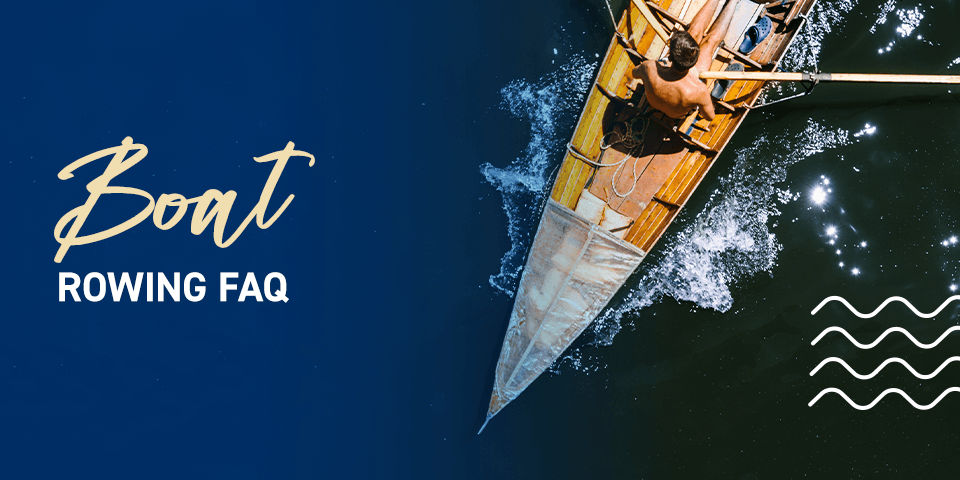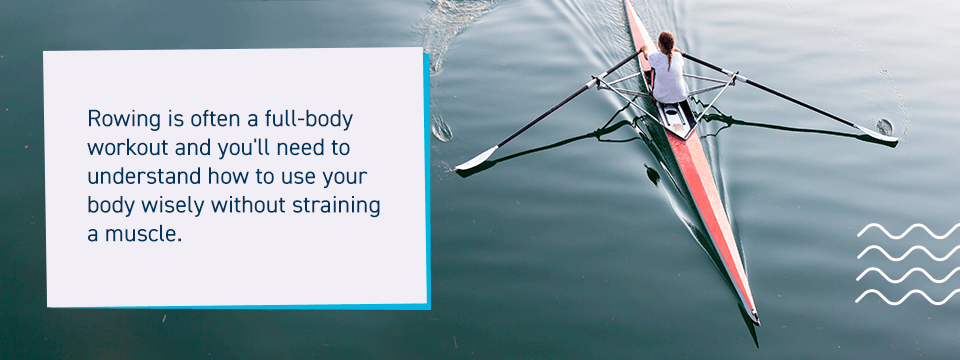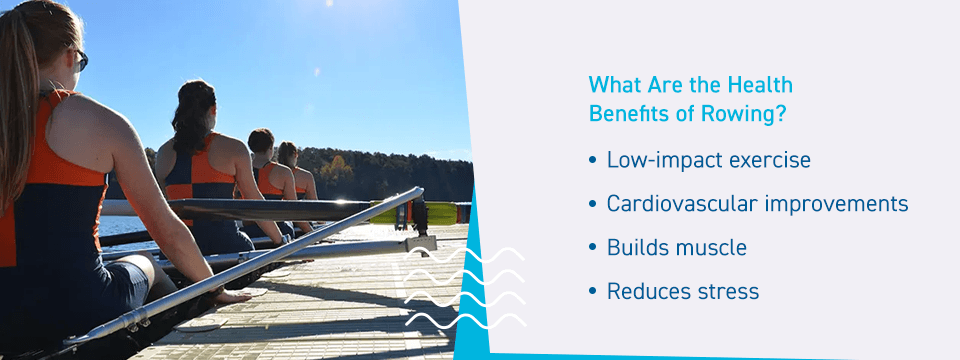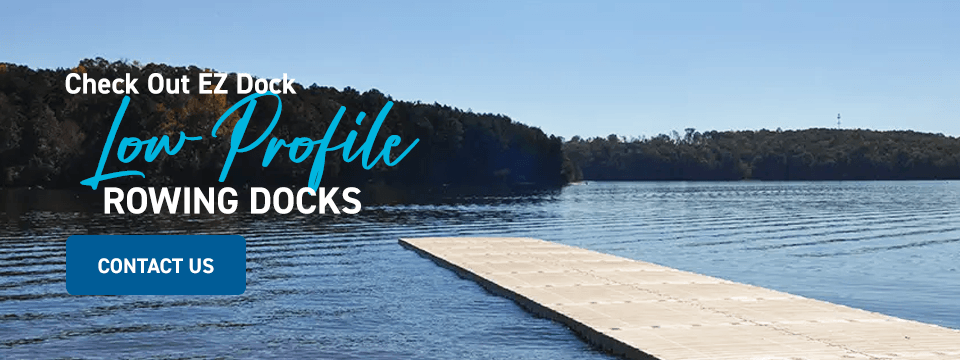Filters
Boat Rowing FAQ
Rowing can be a fun pastime once you understand the ins and outs of the sport. If you want to get started with a personal rowboat or a rowing team, you may want to familiarize yourself with basic terms, exercise requirements and proper rowing techniques.
This boat rowing FAQ contains several common questions about rowing and their answers.
Q. How Do I Get Started With Rowing?
Starting your rowing journey should begin with practicing consistent workouts to improve your rowing skills. Try to learn everything you can about the muscles required for rowing and start looking into muscle relaxation and mindfulness habits.
Progressive muscle relaxation (PMR) helps your body understand your muscles better. After working out, try practicing PMR by contracting and relaxing muscles while taking deep breaths. Rowing is often a full-body workout and you’ll need to understand how to use your body wisely without straining a muscle.
One of the best ways to get started with rowing is to join a rowing club or team. If you’ve never had any experience with rowing, a club can help you keep up with your skills and improve over time. Many teams also have regular practices that introduce you to other rowers.
Q. How Do I Row a Boat?
Learning how to row a boat correctly is one of the most critical aspects of the sport. Before investing in rowing equipment, you’ll want to learn the phases of a stroke and the correct technique and sitting posture. Some elements of the proper technique include:
- Posture: Make sure you sit straight in the seat and keep your head up with your eyes facing forward. Good posture assists with proper rowing actions and prevents pulling muscles in your torso.
- Range of motion: Rowing involves a full range of motion in each stroke. While maintaining good posture, try to reach as far forward as you can as you row the boat. Pushing and compressing your legs helps you improve mobility and achieve a full range of motion during each stroke.
- Rhythm: Keeping a consistent rhythm helps the boat move quickly and maintain a solid ratio.
- Upper body: Upper body movement helps accelerate the boat forward. Keeping your hands close to your body and your forearms horizontal will help in the drive and recovery phases.
- Lower body: Lower body movement helps strengthen the leg muscles and uses some of the strongest muscles in the body.
- Rowing order: Make sure you row in the correct order and avoid shooting in your seat.
Phases of a Rowing Stroke
After learning the proper techniques for rowing a boat, you’ll want to familiarize yourself with the different phases of the stroke. The official steps for the rowing phase include the following:
- Catch: As their body is coiled like a loaded spring, ready to release, the rower drops the oar blade into the water.
- Drive: As the body uncoils, the rower draws the oar blades through the water. The drive phase begins with the catch position and ends with the release position.
- Finish: The finish phase involves moving the oar handle down, which draws the oar blade from the water. The rower simultaneously moves the oar blade to a horizontal position.
- Recovery: In the recovery phase, the oar remains entirely out of the water as the rower moves forward again. The recovery phase ends with the rower back in position for the catch phase.
Q. How Can I Stay Safe When Rowing a Boat?
Rowing safety starts with reviewing the in-depth safety instructions specific to your rowing team or club. You should also follow any regulations set forth by the people who oversee the water you want to row in. Failing to follow the rules and regulations could result in serious injuries.
Some other guidelines to follow:
- Keep up your swimming knowledge: Knowing how to swim is one of the critical components of rowing. Many clubs or teams may require you to pass a swim test and demonstrate a basic understanding of how to use a life jacket before joining.
- Understand rowing terms: You’ll want to familiarize yourself with basic boating terminology, such as bow, stern or stroke. Recognizing basic terms means you’ll know how to communicate with other rowers on the water.
- Understand your water: Try to find out the traffic patterns and potential hazards of the water you plan to row in.
- Stay in shape: Try to stay in shape as much as possible to keep up with the muscle and power you’ll need for rowing. Before beginning any physical regimens, make sure you have a chat with a doctor to determine what exercises would be right for you.
- Warm up on land: Practice land warm-ups before you enter the row boat. Spend some time jumping, running in place or jogging to prepare the body for a workout.
- Warm up on the water: Doing warm-ups when in the boat can help protect you from injuries like strains or pulled muscles. Try working your way up from no-pressure to full-intensity rowing.
- Know what to do if you fall out: If you or someone else falls overboard, try to swim underneath the boat until it passes overhead. Extend floatation devices for those that have fallen out.
- Use lights at night: While rowing at night, it is essential to outfit the boat with lights on the bow and stern.
- Avoid rowing alone in winter: Try not to row alone in winter. If you fall into a body of water below 50 degrees, you could quickly go into shock or experience hypothermia. No matter how good you are at swimming, you may not be able to perform a self-rescue.
Q. What Rowing Terms Do I Need to Know?
Knowing various rowing terms can help new rowers become familiar with the different parts of the sport. From understanding the phases of a stroke to discovering different kinds of rowing boats, rowing involves specific terminology that can help improve your skills.
Some of these terms include:
- Blade: The smooth end of the oar.
- Bow: The rower that sits nearest the bow.
- Bow-coxed boat: A kind of shell rowboat. The coxswain sits near the bow and often lies closer to the floor, reducing wind resistance.
- Button: The wide area on the oar that places the oar in a lock.
- Catch: The first phase of the stroke when the oar enters the water.
- Coxswain: A person who steers the boat and acts as an on-water coach.
- Crab: When the oar blade traps itself beneath the water, or the handle is trapped against the rower, often causing the rower to fall out of the boat.
- Deck: The boat’s bow and stern area, often made of fiberglass cloth or plastic.
- Drive: The second phase of the stroke when the rower pulls the oar handle.
- Ergometer: A machine that mimics the motion of an actual rowboat.
- Feather: Placing the blade parallel to the water. The feather position provides less wind and water resistance.
- Finish: The third phase of the stroke when the handle moves down and the oar lifts out of the water.
- German-rigging: A setup with two rowers with oars on the same side.
- Hands-away: A stroke that pushes the hands away from the body and the blade to the bow. This movement often happens during recovery, when the legs are flat and the hands move over the knees.
- Hull: The outside of parts of the boat.
- Launch: A boat used by a coach or rescue personnel to watch over the safety of the rowers and make safety decisions.
- Layback: Leaning backward on the hips and finishing the oar’s stroke.
- Lightweight: The rower. This term often describes the maximum weight for each rower during an event.
- Oar: A tool used to move the boat.
- Oarlock: A latch on the boat’s side to lock in the oar.
- Recovery: The final phase of the stroke when the rower positions the blade for the catch stroke.
- Release: The part of a stroke when the oar leaves the water.
- Rigger: A triangle-shaped device on the boat’s side that holds the oars in place.
- River-turn: A technique to turn the boat around by pulling one side forward and one backward.
- Rock over: The part of a stroke when the rower extends their arms and their torso rocks around, using their pelvis as a base.
- Rocked over: The part of a stroke after the rock-over phase. The rower’s arms will extend and the torso will rock into the upper body catch position.
- Roll-up: The part of a stroke involving the feather and squaring techniques.
- Run: The distance measured between the oar’s stroke and the boat’s movement.
- Sculls: A kind of rowing technique in which rowers use two oars.
- Seat number: The positions and number of seats on a rowboat.
- Set: Bringing the boat to a balance.
- Shell: The body of a boat.
- Slide: The runners on each set of seat wheels.
- Straight: A boat without a coxswain, often in straight-four or straight-pair boats.
- Stretcher: The place for the rower’s feet with inclined footrests and bolted shoes.
- Stroke: Both the complete rowing cycle from catch to release and the person sitting near the stern and setting the boat’s rhythm.
- Sweep: A kind of rowing technique where rowers use one oar.
- Swing: A motion where the speed and performance of the boat become synchronized.
Q. How Can I Get in Shape to Start Rowing?
Rowing requires a large amount of muscle strength and aerobic endurance. To get in shape for rowing, try building strength and power in your legs, back and butt muscles to enhance your rowing strokes. You may also want to try bodyweight exercises like squats, push-ups and jumping jacks to build your endurance.
Along with bodyweight exercises, perform consistent workouts with crunches, planks and hip and leg lifts. Build muscle memory with an ergometer machine. Work your way up from steady workouts to intensive exercises to practice rowing endurance.
Q. What Are the Health Benefits of Rowing?
From building muscle to reducing anxiety, rowing has benefits that every rower can appreciate:
- Low-impact exercise: Rowing has a low impact on your joints while working out your entire body and muscles.
- Cardiovascular improvements: With a full-cardio rowing workout, you’ll experience increased lung capacity, better circulation and improved heart health.
- Builds muscle: Rowing a boat uses muscles throughout the body. You’ll be able to build and tone various muscle groups, from large muscles in the legs, back and butt to smaller muscles in the arms and hands.
- Reduces stress: Rowing involves consistent motion that requires rhythmic breathing, which can help reduce stress.
- Improves mobility: Rowing requires full-body movements that can help improve mobility and flexibility.
Q. How Much Is a Rowing Boat?
A new or used rowing boat will vary in price depending on which type or size of boat you want. However, you can expect to pay between $1,500 and $15,000. You may also want to budget for new accessories like a roof rack for your boat, slings, shoes and oars, which vary in price.
Q. What Is a Rowing Boat Called?
A rowing boat is often called a shell, made from carbon fiber or plastic. There are two types of shells — crew and sculling boats.
The difference between rowing and sculling is how many oars the rowers use and how many people the boat holds. Sculling is a type of rowing where each rower uses two oars, while sweep rowing requires that all rowers use one oar. There can be one, two or four rowers in official sculling events. On the other hand, sweeping rowing involves two, four or eight rowers.
Q. What Should I Wear for Rowing a Boat?
While you probably won’t enter the water during rowing, it’s better to be safe than sorry. Wear clothes you don’t mind getting wet or dirty and avoid pockets in the front of your clothes. Some safe clothing options include:
- Close-fitting clothes: Choose clothing that fits nicely around the body and isn’t too loose or tight.
- Hats: A well-fitting hat or visor will help keep the sun off your face.
- Sunglasses: Well-fitting sunglasses or shades will help deal with reflected sunlight on the water.
- Shoes: It’s best to wear lightweight shoes like crocs or sneakers in case you fall in the water.
- Socks: Comfortable and breathable socks are a must.
- Sweaters: If you wear a sweater in colder weather, choose one without pockets.
- Raincoats: Investing in a raincoat or water-resistant jacket will help you stay dry.
- Visible colors: Wear bright, visible colors to others in case you need assistance.
Q. What Rowing Accessories Do I Need?
Aside from wearing the proper clothing, you may want to invest in rowing accessories to help you when you’re on the water. Some helpful rowing accessories include the following:
- Rowing socks: These special socks are made from nylon or moisture-wicking material.
- Rowing shoes: You can find special shoes with rigid soles and cold or heat protection.
- Seat pad: A cushion can give you some padding without hindering movement.
- Calf protectors: These guards protect your calves from sores or blisters.
- Overgrip or sculling grips: Tape provides grip and comfort at the end of the oar.
Q. What Weather Conditions Are Best for Rowing?
Calm weather is ideal for rowing. Avoid rowing in extremely cold or hot temperatures and on very windy days. Low air or water temperature could cause hypothermia, and extreme heat may result in dehydration.
Check Out EZ Dock Low Profile Rowing Docks
EZ Dock has served commercial, government, industrial and residential customers worldwide since 1991. If you are looking for a low-profile rowing dock for you or your rowing team, EZ Dock has solutions that offer strength, stability and eco-friendly materials. Contact us today to speak to a representative and find the right dock system for you.















